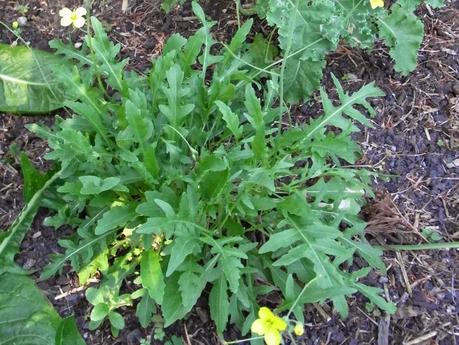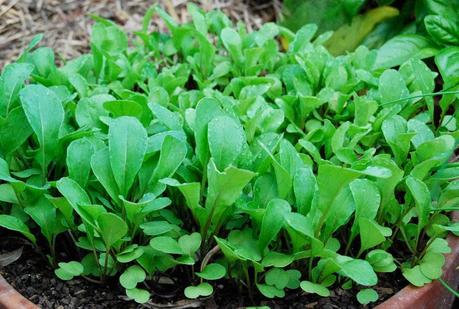So you don't like rocket (or arugula)? Too peppery, eh? You're not alone if you just can't see what others see in rocket, but please believe me when I say countless restaurants keep on dishing up the wrong stuff. And many backyard gardeners leave it too late and eat old, peppery rocket rather than the lovely, young, nutty-flavoured salad green that we love to eat.
There are in fact many different types of rocket, but here in Australia you come across two basic types. Both can be hot and peppery if the leaves grow too big, and both can be utterly wonderful in salads when the leaves are harvested young. These two types are commonly known as "wild rocket" (the one with serrated leaves) and "cultivated rocket" (the one with more rounded paddle-shaped leaves). Here's some pix to make it clearer.

Wild rocket, otherwise known as Diplotaxis murals or Diplotaxis
erucoides. The one with the serrated leaves that is what you most
commonly find in Australian greengrocer shops. To cut a longish
story short, this is now my favorite rocket to grow at home. As
for the reasons why, read on...

Cultivated rocket (Eruca vesicaria ssp sativa). This stuff looks
and tastes lovely when very young, like this pot-full, but neglect it
and in a matter of weeks it's too big, too peppery and you have to
start all over again. Thank goodness it grows so fast but it is a
fair bit of work keeping a good steady supply of baby rocket
like this growing along. I could never manage it properly.
I am sure the suspense is bearable, but if you're still with me, there's a number of reasons why I recommend growing wild rocket at home, rather than cultivated rocket.
1. Wild rocket is a perennial plant. It lives for a number of years, while the cultivated type of rocket is a completely different thing. It's an annual, and its useful lifespan in the garden is just a couple of months at the very most.
2. You can grow wild rocket very well from seed or seedlings. I find that the cultivated type of rocket grows much better from seed. Sure, seedlings are sold in nurseries, but that means a cultivated rocket seedling might only be usefully nutty and pleasant in flavor for about a month, before it becomes too peppery.
3. Wild rocket just keeps on coming back if you harvest some regularly. In fact, that's the trick to growing and using it – harvest it often. That way the plant is covered in new, tender, nutty, baby leaves pretty well all the time. When harvesting yet another handful for a mixed salad, if I see a big leaf has somehow miraculously made it to that big size, I cut it off and leave it there on the ground as mulch.
So, is there any reason why cultivated rocket is worth growing in the garden? Of course! It has a superb light texture and nutty flavor when served as a salad of baby leaves. What I mean by 'baby' leaves is small, paddle-shaped guys less than 10cm (4 inches) long, such as in my potted photo above (and below). This is the kind of nutty, tender rocket which you can have a whole salad of on its own. (The wild rocket isn't such a dazzlingly lovely thing in a whole salad on its own. It's at its best in a mixed leaf salad, in my humble opinion).
Another great reason to grow cultivated rocket is the sheer sporting good fun of having something grow at lightning speed. It's a terrific plant to include in a kids' patch of plants grown from seed. Sow whatever you like, but the rocket will almost certainly come up first, usually in four or so days (depending on the weather).Growing cultivated rocket from seed: as for how to sow the seeds, try this simple method…

The seeds are tiny. So set up a pot of potting mix. You don't need
a deep pot, either – a wide shallow one is best. Scatter the seeds
over the mix evenly (one teaspoon of seeds should cover a pot
about 30cm across at the top). Once you've scattered the
seeds over the surface, cover with (ideally) a fine layer of
seed-raising mix (popular here in Australia) no deeper than
2-3mm deep (that's thin). Some overseas readers have in the
past asked "what is seed-raising mix?". It's a fine, light, sandy
propagating mix. You should be able to find something similar. Water
the soil surface with a fine, misty spray and leave it be.
Harvesting cultivated rocket: now, here's how to make short-lived cultivated rocket last a bit longer. When the cultivated rocket is about the size (leaves 7-10cm tall) in the photo below ...

… get out a pair of scissors and cut about half a pot-full down near to the stumps of the plants. You'll get a nice bowl-full from that, which you can enjoy soon after as a baby rocket salad, maybe drizzled with the finest olive oil you can afford, some balsamic vinegar or some vino cotto.
Then feed the pot again soon after. Yes, it's a risky maneuver cutting the plants down to their stumps (ie, it doesn't always work!) but I find eight times out of ten I'll get a second crop if I fertilise the pot soon after this radical harvest. So, for this one 30cm pot, you should get at least four nice baby rocket salads before the plants start to become a bit too tired for too many more deep cutbacks down to the stumps.
Growing wild rocket: as for growing the wild rocket that I prefer, I think it'd be best to grow it from seedlings. You'll only need a couple of plants, and they should live on for a few years, and so a packet of 500 seeds seems just a bit wasteful (and silly) to me.
It's not a bad time to plant rocket now, as spring is just around the corner, and this is one plant that loves spring and autumn a whole lot more than it likes Aussie summers (which is not a lot, in fact).
Finally, for more on other rocket varieties, there's no better blog than Michelle's "From Seed to Table" and her experience with growing rocketis well worth reading.
